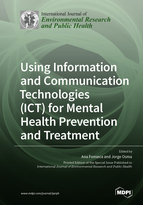Using Information and Communication Technologies (ICT) for Mental Health Prevention and Treatment
A special issue of International Journal of Environmental Research and Public Health (ISSN 1660-4601). This special issue belongs to the section "Digital Health".
Deadline for manuscript submissions: closed (30 September 2020) | Viewed by 81325
Special Issue Editors
Interests: E-mental health; Clinical Psychology; Perinatal mental health; Cognitive-Behavioral Therapy; Professional help-seeking behaviors; Prevention and treatment of mental health issues
Interests: reproductive and perinatal mental health, prevention; evidence-based psychological interventions; transdiagnostic; emotion regulation; emotional disorders; e-health; m-health
Special Issues, Collections and Topics in MDPI journals
Special Issue Information
Dear Colleagues,
Mental illness is a recognized population health issue, with depression and anxiety disorders being prevalent around the world (4.4% and 3.6% of the global population suffer from depression and anxiety disorders, respectively; World Health Organization (WHO), 2017), and across different regions. Depression is ranked by WHO as the single largest contributor to global disabilities (7.5% of all years lived with disability in 2015; anxiety disorders are ranked 6th). The estimate cost of depressive and anxiety disorders to the global economy in lost productivity is US $1 trillion per year (WHO, 2019). Despite the negative consequences of mental health disorders, we still face inequalities in treatment access (e.g., limited resources to accommodate the existent needs) and/or barriers to treatment, such as knowledge barriers (e.g., poor mental health literacy), attitudinal barriers (e.g., stigma towards mental health and towards professional help-seeking), and structural barriers (e.g., limited access to healthcare due to geographical or financial restrictions, work constraints or patient’s physical condition). Therefore, the use of information and communication technologies (ICT) to deliver psychological interventions may be an effective way to improve the patient’s access and use of mental healthcare services, considering its characteristics (e.g., convenience and flexibility of use, privacy, novelty, and appeal). The use of ICT in psychological intervention may be complementary to face-to-face services, but also the sole means of access to psychological interventions (e.g., web-based intervention programs).
The aim of this Special Issue entitled “Using Information and Communication Technologies (ICT) for Mental Health Prevention and Treatment” is to publish studies concerning the acceptability, (cost-) effectiveness, potentialities, and limitations of ICT-based psychological services (e.g., web-based interventions, mobile devices, and virtual reality) for mental health promotion, prevention, and treatment.
Dr. Ana Fonseca
Dr. Jorge Osma
Guest Editors
Manuscript Submission Information
Manuscripts should be submitted online at www.mdpi.com by registering and logging in to this website. Once you are registered, click here to go to the submission form. Manuscripts can be submitted until the deadline. All submissions that pass pre-check are peer-reviewed. Accepted papers will be published continuously in the journal (as soon as accepted) and will be listed together on the special issue website. Research articles, review articles as well as short communications are invited. For planned papers, a title and short abstract (about 100 words) can be sent to the Editorial Office for announcement on this website.
Submitted manuscripts should not have been published previously, nor be under consideration for publication elsewhere (except conference proceedings papers). All manuscripts are thoroughly refereed through a single-blind peer-review process. A guide for authors and other relevant information for submission of manuscripts is available on the Instructions for Authors page. International Journal of Environmental Research and Public Health is an international peer-reviewed open access monthly journal published by MDPI.
Please visit the Instructions for Authors page before submitting a manuscript. The Article Processing Charge (APC) for publication in this open access journal is 2500 CHF (Swiss Francs). Submitted papers should be well formatted and use good English. Authors may use MDPI's English editing service prior to publication or during author revisions.
Keywords
- Web-based interventions
- Mobile devices
- Telepsychology
- E-mental health tools: Internet, virtual reality, ecological momentary assessment, tablets, sensors, etc
- Mental health
- Promotion, prevention, and treatment
- Psychological interventions
- Acceptability
- Usability
- Cost-effectiveness







